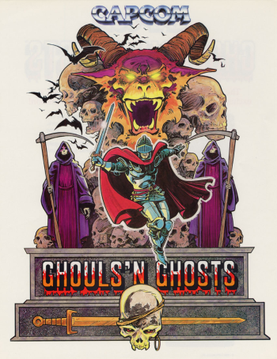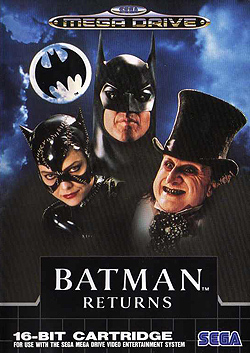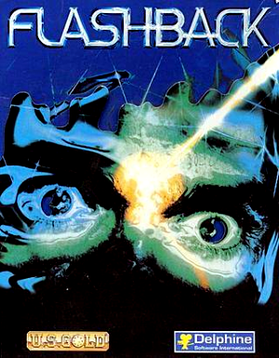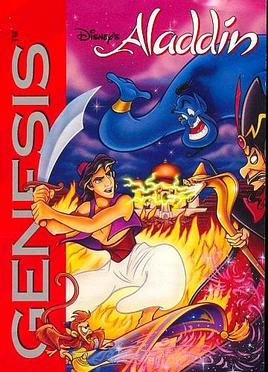
The Sega CD, known as Mega-CD in most regions outside North America and Brazil, is a CD-ROM accessory for the Sega Genesis produced by Sega as part of the fourth generation of video game consoles. It was released on December 12, 1991, in Japan, October 15, 1992, in North America, and April 2, 1993, in Europe. The Sega CD plays CD games and adds hardware functionality such as a faster CPU and graphic enhancements such as sprite scaling and rotation. It can also play audio CDs and CD+G discs.

The Master System is an 8-bit third-generation home video game console manufactured and developed by Sega. It was originally a remodeled export version of the Sega Mark III, the third iteration of the SG-1000 series of consoles, which was released in Japan in 1985 with graphical capabilities improved over its predecessors. The Master System launched in North America in 1986, followed by Europe in 1987, and then in Brazil and Korea in 1989. A Japanese version of the Master System was also launched in 1987, which features a few enhancements over the export models : a built-in FM audio chip, a rapid-fire switch, and a dedicated port for the 3D glasses. The Master System II, a cheaper model, was released in 1990 in North America, Australasia and Europe.

Ghouls 'n Ghosts, known as Dai Makaimura in Japan, is a side-scrolling platform game developed by Capcom, released as an arcade video game in 1988 and ported to home platforms. It is the sequel to Ghosts 'n Goblins and the second game in the Ghosts 'n Goblins series.

Comix Zone is a 1995 beat 'em up video game developed and published by Sega for the Genesis. It is set within the panels of a comic book with dialogue rendered within talk bubbles and sprites, and backgrounds possessing the bright colors and dynamic drawing style of superhero comics. This style is in previous video games, for example Ocean Software's Batman: The Caped Crusader in 1988, but Comix Zone stretched the idea to such an extent that Sega applied for and was granted a patent for a "videogame system for creating a simulated comic book game".

Batman Returns is the name of several video games for various platforms based on the 1992 film of the same name.

Flashback, released as Flashback: The Quest for Identity in the United States, is a 1992 science fiction cinematic platform game developed by Delphine Software of France and published by U.S. Gold in the United States and Europe, and Sunsoft in Japan.

Snow Bros. is a 1990 platform arcade video game originally developed by Toaplan first published in Japan, then in North America by Romstar and later in Europe. Starring the eponymous snowmen twins Nick and Tom, players are tasked with travelling through 50 stages, throwing and building snowballs, jumping on and off platforms to navigate level obstacles while dodging and defeating monsters in order to rescue the princesses Puripuri and Puchipuchi from captivity. Although first launched in arcades, the game was later ported across multiple platforms, each one being created by different third-party developers and featuring several changes or additions compared with the original version. Conversions for various microcomputers were in development but none were officially released to the public.
Newsfield Publications Ltd was a British magazine publisher during the 1980s and early 1990s.
Michael Jackson's Moonwalker is the name of several video games based on the 1988 Michael Jackson film Moonwalker. Sega developed two beat 'em ups, released in 1990; one released in arcades and another released for the Sega Genesis and Master System consoles. U.S. Gold also published various games for home computers the same year. Each of the games' plots loosely follows the "Smooth Criminal" segment of the film, in which Jackson rescues kidnapped children from the evil Mr. Big, and incorporates synthesized versions of some of the musician's songs. Following Moonwalker, Jackson collaborated with Sega on several other video games.

The Revenge of Shinobi, released in Japan as The Super Shinobi, is a hack-and-slash action video game developed and published by Sega in 1989. It was the first Shinobi game developed for the Sega Genesis, and was later released on the coin-operated version of that console, the Mega-Tech.

Hyper was a multi-platform Australian video game magazine. It was Australia's longest running gaming magazine, published from 1993 to 2019.

Castle of Illusion Starring Mickey Mouse is a 1990 platform game developed and published by Sega and released for the Mega Drive/Genesis. An 8-bit version of the game was later released for the Master System and Game Gear. The game follows Mickey Mouse on a quest to save Minnie Mouse from the evil witch Mizrabel. It is the first game in Sega's Illusion video game series starring Mickey.

Alisia Dragoon is a 1992 platform game developed by Game Arts for the Sega Genesis. The player controls Alisia, a young woman who is on a quest to avenge her father and save the world. She can fire lightning from her hands and summon four faithful beasts to aid her. Alisia Dragoon was published outside of Japan by Sega. Despite the acclaim the game received, it was not a commercial success. The game was later included on the Sega Genesis Mini and Nintendo Switch Online.

The Sega Genesis, also known as the Mega Drive outside North America, is a 16-bit fourth generation home video game console developed and sold by Sega. It was Sega's third console and the successor to the Master System. Sega released it in 1988 in Japan as the Mega Drive, and in 1989 in North America as the Genesis. In 1990, it was distributed as the Mega Drive by Virgin Mastertronic in Europe, Ozisoft in Australasia, and Tectoy in Brazil. In South Korea, it was distributed by Samsung Electronics as the Super Gam*Boy and later the Super Aladdin Boy.

Taz Mania is the name of several video games based on the Taz-Mania cartoon series. A 2D side-scrolling platform/adventure video game developed by Recreational Brainware and published by Sega on the Sega Mega Drive/Genesis in 1992. Different games were also developed by NuFX and released on the Game Gear and by Technical Wave on the Master System. Other different Taz-Mania games were also published by Sunsoft in North America and by THQ in PAL terrotories and released on the SNES and 2 games on the Game Boy were made too. One from David A. Palmer Productions and published by Sunsoft and another one called Taz-Mania 2 from Beam Software and published by THQ.

Valis III is a 1990 action-platform video game originally developed by Laser Soft, published by Telenet Japan and NEC for the TurboGrafx-CD. A Sega Genesis version was released in 1991. It is the third entry in the Valis series. It stars Yuko Asou, a Japanese teenage schoolgirl chosen as the Valis warrior and wielder of the mystical Valis sword after the events of Valis II. King Glames, wielder of the sword Leethus, leads denizens of the dark world to conquer both Vecanti and Earth, seeking refuge for his people amid the destruction of their planet. Together with the demon warrior-maiden Cham and her sister Valna, Yuko must prevent Glames from destroying both worlds. Through the journey, the player explores and searches for items and power-ups while fighting enemies and defeating bosses.
Micro Machines is a series of video games featuring toy cars, developed by Codemasters and published on multiple platforms. The series is based on the Micro Machines toy line of miniature vehicles.

Paragon Publishing Ltd was a magazine publisher in the UK, which published computer games and other entertainment titles from 1991 to 2003.

The Zone was an Australian video game focused television program that aired on the Nine Network on Saturday mornings at 8:30AM AEST from 30 April 1994 to 1 July 1995. The show was produced by Beyond Television Productions and was hosted for the majority of its run by Adam Reilly.

Disney's Aladdin is a platform game based on the 1992 film of the same name developed by Virgin Games USA. The game was released by Sega for the Sega Genesis on November 11, 1993 as one of several games based on the film, including another game that was released in the same month by Capcom for the Super NES.
















